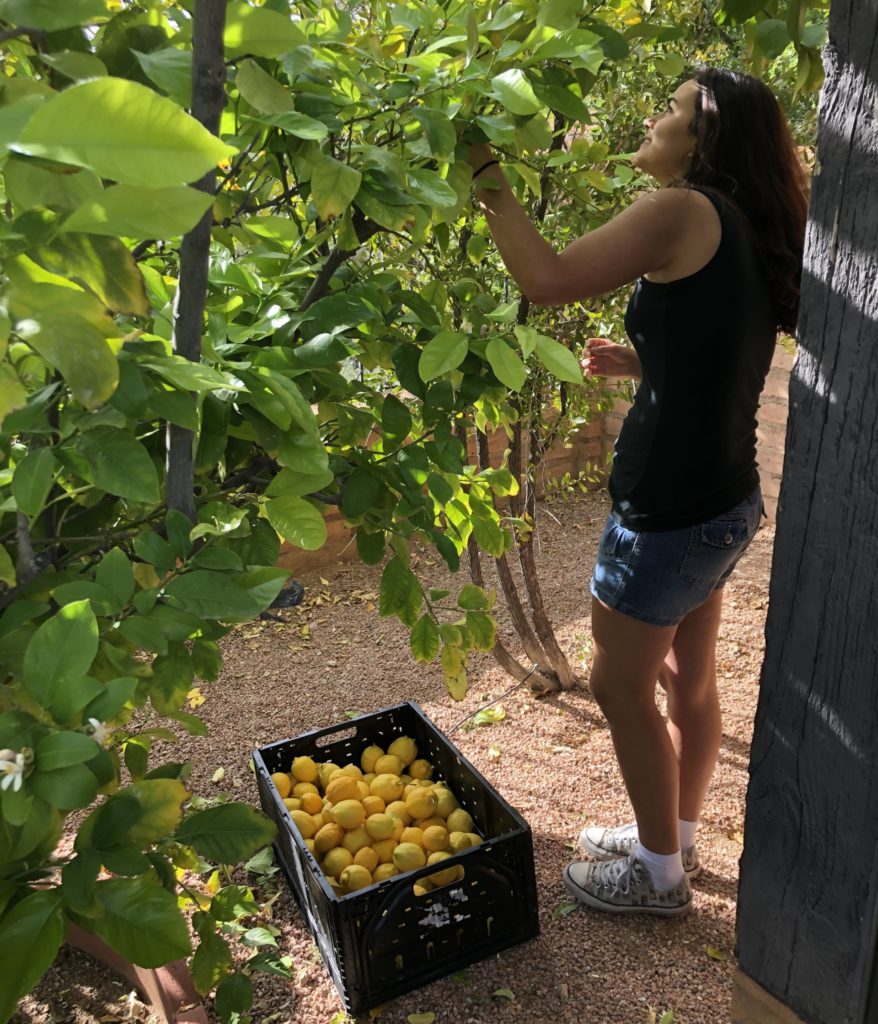How Can We Help?

Fruit Tree Gleaning during COVID-19
Iskashitaa created and is continually modifying this harvest model to safely continue feeding families and not landfills during the COVID-19 pandemic. This was the procedure that was followed starting March 2020 at the beginning of the Arizona quarantine measures. A mini harvest is where a group/household of up to 5 volunteers are assigned a property from the Iskashitaa fruit donor database and use Iskashitaa harvest supplies: picking poles, crates, harvest bags, harvest sign-in clipboard, etc. to independently harvest the tree with minimal to no supervision from Iskashitaa.
PREPARATION
This process started by Iskashitaa announcing the new harvest approach on social media and in the newsletter, notifying them that moving forward the harvesting model will only be mini harvests. This prompted the volunteer base to reach out to the Volunteer Manager with: their contact information, availability (dates and times), # of people in their group, preferred location of town to harvest (North, South, East or West side of Tucson), and their capacity to carry supplies (if they had a pick-up truck they would be assigned to a property that would require a ladder but if they had a smaller car they would be assigned a smaller tree, etc.). Be as specific as needed regarding the information solicited from your volunteers; in retrospect, IRN was too accommodating to the volunteers’ availability, creating more work on the administrative end.
This information would be put on the IRN Gsuite calendar. Iskashitaa has many calendars; the event would be created under the harvesting calendar on their specified availability with the following format:
Title of event– TENT: Firstname Lastname Harvest
For example, TENT: Kate Crooks Harvest
In calendar event’s notes– Other information asked for:
WHO: how many people, and the point of contact’s phone and email
WHAT: Harvest Coordinator fills this part out> and their capacity to carry supplies.
WHERE: preferred location
Once the event was entered on the calendar, the Volunteer Manager would text the Harvesting Coordinator the volunteer’s name and the date that they were on the calendar (For example, Kate Crooks 06/15).
It was the Harvest Coordinator’s responsibility to set up the harvest time and verify details with the homeowners for harvesting their property. It was and still is important to contact the homeowner to verify if they want volunteers arriving at their homes during COVID-19 if they submitted their property on the Fruit Donor Form before the Arizona quarantine measures were in place, some had specified that they don’t want to be harvested until the pandemic is over. When the Harvesting Coordinator received the calendar information she decided what property to assign the volunteers based on the size of the property (some have several trees and some only have 1) and the equipment necessary (is a ladder required, clippers, etc.).
Once the Harvesting Coordinator has the confirmation from the homeowner, she would change the Gcalendar event to just the volunteer name (remove TENT) and add the number of trees they would be harvesting in parenthesis (Kate Crooks Harvest (2)). She would then notify the Volunteer Manager via text that the mini harvest was established and the details needed to be confirmed with the volunteers. Once the volunteers confirmed with the Volunteer Manager, a message would be sent back to the Harvest Coordinator stating that the mini harvest was fully established.
The Volunteer Manager would then send the volunteer a new email separate from their volunteer inquiry with the subject line Independent Harvest (6/15) and then say that they were confirmed to harvest and that they should come to our office at X:XX time to pick up the harvesting supplies (picking poles, crates, and harvest clip board at a minimum).
It is important to prompt the volunteer to confirm that they have received the email, read the instructions, and can still commit to that proposed date and time for harvesting.
AT THE EVENT
Iskashitaa requires/required all harvesters to wear masks when they came to the office, same with staff members who were in the office to facilitate supplies pick-up. The volunteers would pick-up the supplies themselves from the office’s designated “clean area” and received a harvest clipboard with property information (address, homeowner contact, tree type and quantity of trees, any special directions like gate codes or side streets to follow), harvesting instructions (how to sort the fruit as you are picking it), and volunteer waivers if they were new volunteers (the waiver covers liability so they claim responsibility if an injury occurred during harvesting). With all of that information IRN provided, the volunteer would go to the site, harvest, and then bring back the fruit & supplies.
After returning from the harvest, volunteers notified the staff in the office they had returned by ringing the office doorbell. The used picking pole went into a designated area for sanitizing and would be put back with the rest once they were cleaned. Since what was harvested was citrus and the peel wasn’t always eaten (sometimes it’s used for zest and other seasonings) it was not washed or the crates that held the fruit.
Due to the changing nature of the pandemic response and keeping health of the community a priority, Iskashitaa will be further refining this model for optimal efficiency and safety. Also, while these procedures were tailored to Iskashitaa Refugee Network’s gleaning and volunteer practices, it is encouraged that they are implemented and tailored to other interested gleaning organizations as they all work together towards protecting and nourishing communities.


